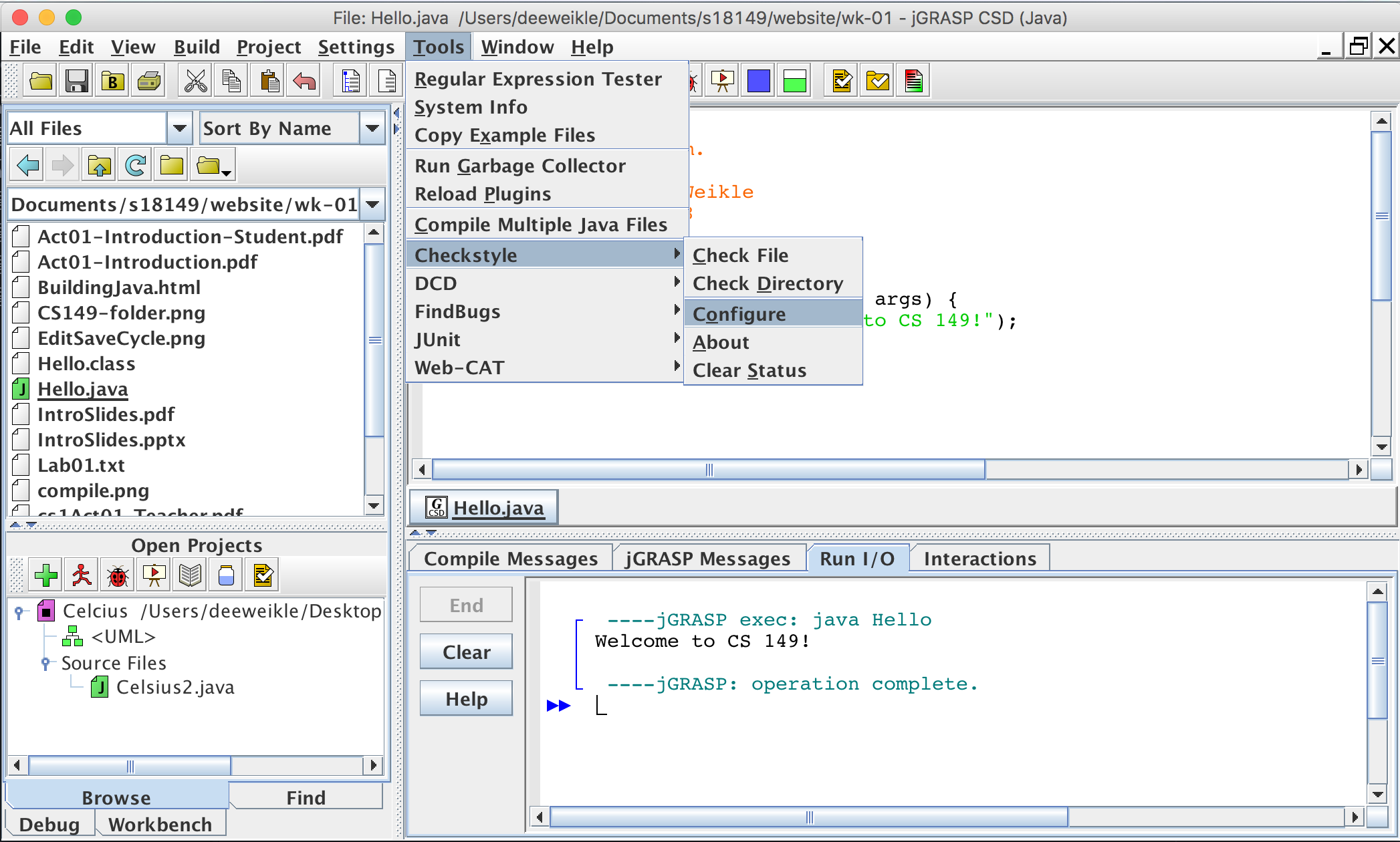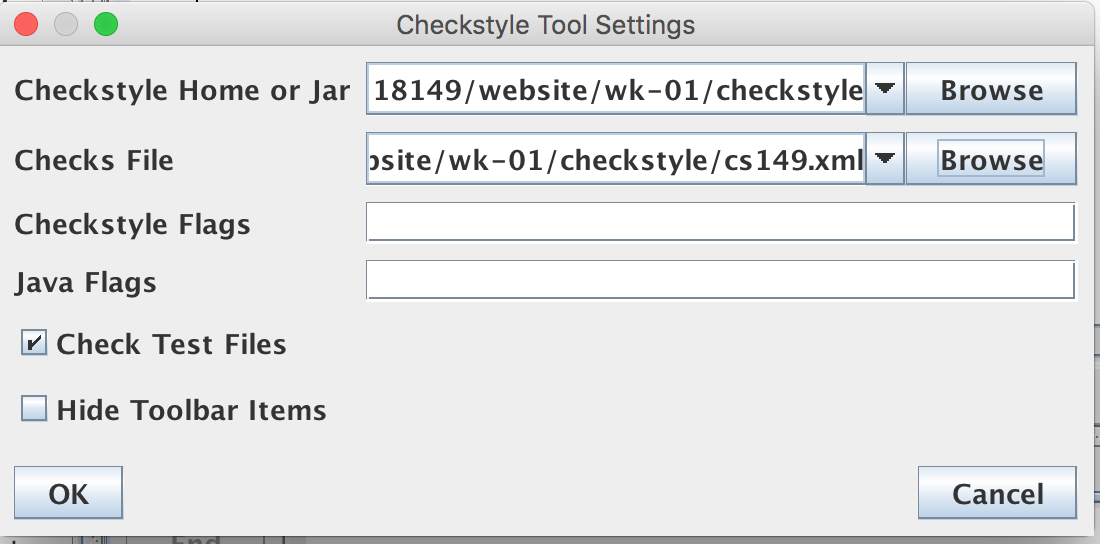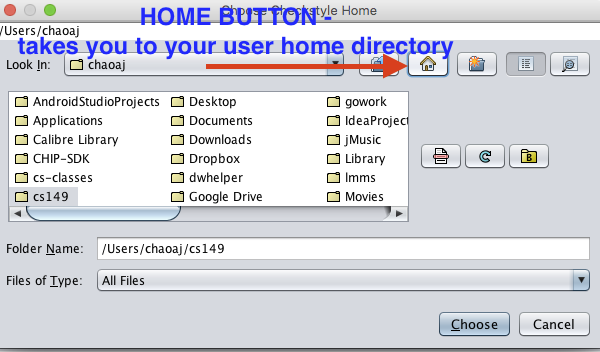/** * CS149 - Programming Fundamentals * Department of Computer Science * James Madison University * @version Fall 2019 */
Style Guide and Checkstyle for CS 149
Background
Virtually every organization that does software development has strict guidelines on how to format source code. Here are two examples of "industrial strength" Java style guides:
Code Conventions (Apr 1999)
Google Java Style (Sep 2017)
This course will more or less follow a simplified version of these guidelines. Rather than memorize a long list of rules, you should develop good habits and intuition when it comes to style.
Checkstyle is a tool that can be used to determine if your source code follows a set of style rules. It also checks for common programming mistakes, such as empty statements and accidental assignment.
Checkstyle Jar and Configuration Files
Download these two files into your home directory:
checkstyle-8.11-all.jar - command-line tool
CS149-Checkstyle.xml - configuration file for CS 149
Running Checkstyle from the Command Line
Make sure the two files you downloaded above are located in the same directory as your code. (Feel free to just save a new copy of the files in your working directory.)Open a terminal and use the following command to run Checkstyle:
java -jar checkstyle-*-all.jar -c CS149-Checkstyle.xml *.java
Note the * characters are wildcards that match whatever version of Checkstyle you have and whatever java source files are present. The output indicates the file and line number of each problem. The following example refers to a method beginning on line 93, char 5 of Hello.java:
Hello.java:93:5: Missing a Javadoc comment
Running Checkstyle Through jGRASP
After you have downloaded the Checkstyle .jar file and the .xml configuration file, open jGRASP and select:
Tools -> Checkstyle -> Configure.

In the "Checkstyle Tool Settings" dialog box set "Checkstyle Home" to

be the folder containing the .jar file(probably /usr/home/stu/stu-f/eid/cs149/lab04), and "Checks File" to be the CS149-Checkstyle.xml file, then click "OK". TIP: You can use the HOME button when hitting the Browse button on the checkstyle dialog to go to your users home folder in Linux as shown below

If all went well, you should see two new buttons on the jGRASP toolbar:  and
and  . Clicking the first button will run Checkstyle on the current file in the editor window. Clicking the second button will run Checkstyle on all of the Java files in the current directory.
. Clicking the first button will run Checkstyle on the current file in the editor window. Clicking the second button will run Checkstyle on all of the Java files in the current directory.
Also, You may want to setup jGRASP to indent properly and handle tabs well. In the jGRASP menu select:
Settings->CSD Window settings -> Workspace. Select the Soft Tabs checkbox then set tab size to 4.
If you apply Checkstyle to your source code often, you will likely internalize good style habits over time. Note however that Checkstyle is unable to evaluate the quality of comments, meaning of variable names, and placement of declarations.
A. Comments
- Every class must contain a Javadoc comment with the following three elements.
- All methods (including
main) must contain an applicable Javadoc comment. - In-line comments (
//) should describe major structures and steps within a method. - All comments should use normal English spelling and grammar. Phrases are okay.
- Comments must come before the code that they are describing or on the same line.
/** * Overall description of the class goes here. * * @author Your name goes here * @version Due date goes here */
/** * Overall description of the method goes here. * * @param paramterName describe each input parameter * @param anotherParam use a separate line for each * @return describe the value that this method returns */
B. Names
- All names should be descriptive and readable.
(
subTotalrather thans,graderather thangrd) - Multiple-word names should use capital letters to separate words.
(
subTotal, notsub_total) - Variable and method names should begin with a lowercase letter, and:
- Variable names should be nouns or noun phrases. (
studentNameorsubTotal) - Method names should be verbs or verb phrases. (
printLineoraddColumn)
- Variable names should be nouns or noun phrases. (
- Class names should begin with a capital letter and use title case. (
HelloWorld) - Constant names should be all caps with an underscore separator. (
PIorINTEREST_RATE)
C. Declarations
- All constants should be named and initialized at the top of the method in which they are used.
- All variables should also be declared at the top of the method, directly after any constant declarations.
- It is strongly recommended (in CS 149) to separate variable declaration and initialization statements.
- Each declaration should be on its own line. Comment to the right if the name is not self-explanatory.
final double CENTIMETERS_PER_INCH = 2.54; centimeters = inches * CENTIMETERS_PER_INCH; // NOT inches * 2.54;
Scanner input = new Scanner(System.in); // discouraged Scanner input; input = new Scanner(System.in);
D. Literals
- Numeric literals should be of the correct type for the context in which they are used.
// integer expressions should use integer literals int a; double b; a = 2; b = 2.0; // double expressions should use double literals double x; double y; double average; average = (x + y) / 2.0; // NOT 2, which is an integer
E. Indentation
- Subsections of code should be indented consistently with four spaces.
- Always use four space characters, not tab characters, for indentation.
- Statements too long for one line should be indented on subsequent lines.
- All blocks of code (even if one line) should be surrounded by curly braces.
- Left braces must appear at the end of the same line as the structure header.
F. Whitespace
- There should be a space after cast operators, commas, and //'s.
- Use whitespace to separate logical segments of code. There should be a blank line after variable declarations.
- Lines should be kept to a short length (< 80 chars). You should be able to see the full line in your text editor.
- Binary operators should be separated from their operands by a single space.
(
sum = myGrade + yourGrade;) - The dot (
.) operator, on the other hand, should not have any space surrounding it. (System.out.println();) - Unary operators should also not be separated by a space.
(
myGrade++;)
